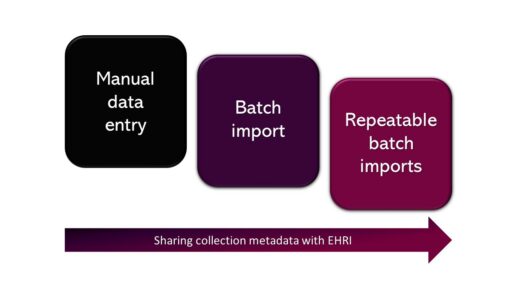EHRI for Collection Holding Institutions: Integrate Your Data in the EHRI Portal

Information on sources on the Holocaust is essential to allow for Holocaust research, education and commemoration. Are you or your institution preserving sources on the Holocaust and you wish for them to be as visible as possible? Read here how their information can be made available in the EHRI Portal!
Why EHRI?
The EHRI Portal offers access and connectedness to information on Holocaust-related archival material held in institutions across Europe and beyond. Integrating descriptions of data held in your archive into the EHRI Portal will help raise the international profile of your institution, increase the visibility of your data and institution, make your data Findable, Accessible, Interoperable and Reusable (FAIR), and connect you to a group of other institutions and professionals with whom you can share expertise. Importantly, you still maintain control of your data once it has been added to the Portal.
A short introductory video about the Portal is available here.
It is very important for people to know where archives are located and if records can be consulted. As a first step, therefore, you should check whether your institution, or you as a private individual, are registered in the EHRI Portal. If you are not, please contact us at archives@ehri-project.eu, with the subject ‘new input for the EHRI Portal’, to let us know about the institution you would like to add.
What (meta)data does the portal support?
The EHRI portal provides access to archival descriptions, also known as finding aids or holdings lists, for Holocaust-related material. Archival descriptions provide information to researchers about the structure of the material, its format, its contents and how they may be able to access it themselves.
The material itself, and any digital reproductions of it that may have been made and be available online, remain in the custody of their holding institution. This distinction is sometimes referred to as between “data” (the archival material itself) and “metadata” (descriptions of the data.)
Selecting relevant material
A question to ask is whether all of your collections descriptions are related to the Holocaust? If not, is your institution able to select only those which are Holocaust related? Contact EHRI if you have questions about this.
How can I share my archival description metadata with EHRI?
There are several different ways to integrate your collection metadata into the EHRI portal, with different degrees of technical involvement:

|
Manual data entry |
Entering collection descriptions directly into the EHRI Portal using an administrative account. |
|
Batch import |
EHRI imports your collection directions from XML (preferably in the standardised Encoded Archival Description – EAD format). |
|
Repeatable batch imports |
EHRI automatically downloads your collection metadata from a web-accessible location and imports it, repeating the process at regular intervals to ensure your descriptions are up-to-date. |
Next steps
If you wish to receive support from EHRI during this process, please know that EHRI has an EHRI Mobile Lab and that we can offer support, possibly even at your location, so please contact us with any questions you may have at archives@ehri-project.eu
FAQ
What data format does EHRI use for batch import?
EHRI uses the EAD 2002 format for importing archival descriptions into the portal. Aside from being valid according to the EAD schema, we also require that every archival unit (in EAD, a component identified with a <did> section) has a <unitid> identifier that is unique among its sibling units. This restriction is not mandated by the EAD schema, which accepts “anonymous” units but is necessary in order that users can identify the source of the data. Preferably, each <unitid> is unique within the whole institution but this is not a hard requirement.
EHRI also normalises data prior to import to remove certain uncommonly-used EAD elements mainly related to text formatting that are not yet supported by the portal.
What if I can’t provide EAD data?
We are aware that not all tools support EAD. For this reason we have tools that can convert arbitrary XML formats into EAD prior to import, as long as it meets certain structural requirements such as there being no more than one collection/fonds per file. EHRI’s mobile lab is happy to advise with regard to technical requirements.
For data that is not in XML format, such as CSV or Excel files, a bespoke conversion might be required.
What about EAD-3?
While it has not undergone as much testing as EAD 2002 we do support import of the newest EAD variant, EAD-3.
Do you support multilingual finding aids?
We can import multilingual finding aids via EAD as long as each language is in its own XML file. We do not yet support the multilingual capabilities of EAD-3.
